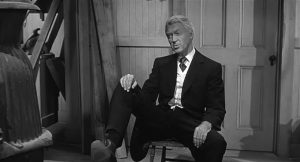THE American WESTERN
By Jeffrey-Baptiste Tarlofsky
By Jeffrey-Baptiste Tarlofsky
Lesson 26 consists of 6 video lectures and transcripts of those lectures, and 5 film excerpts. Start with the lecture, Part 1 and continue down the page in sequence until you reach the end of the lesson.
レッスン26は、6本のビデオレクチャー(レクチャーのテキストがビデオレクチャーの下に記載されています)と5本の動画で構成されています。
このレッスンは、最初のLecture Part 1から順番に動画を見たりテキストを読んでください。
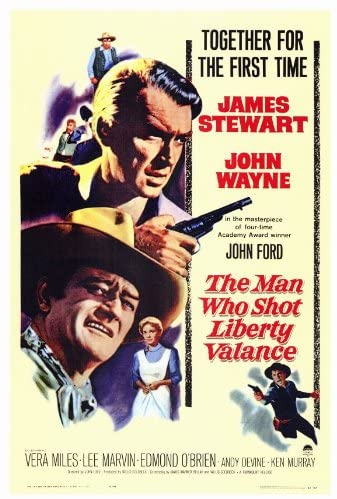
Directed by John Ford
Produced by Willis Goldbeck
Screenplay by James Warner Bellah and Willis Goldbeck
Based on a 1953 short story by Dorothy M. Johnson
Starring John Wayne, James Steward, Lee Marvin, Vera Miles
Music by Cyril J. Mockridge
Cinematograph: William H. Clothier
Running time: 123 minutes
Budget: $3.2 million
Box office: $8 million
Part One
John Ford’s The Man Who Shot Liberty Valance is an almost perfect film for studying the foundations and principles of American Democracy. As Ransom said, “We have begun the school by studying our country and how it is governed”. Ford explores both the Declaration of Independence, which declares “all men are created equal”, and the Constitution, which sets out the basic laws of the nation. Ford is making sure the audience understands that the fundamental conflict in the film is between the “rule of law”, which is written down, and “the rule of men”, which is rule by the strongest. Ransom writes “Education (i.e., literacy – the ability to read and write) is the foundation of law and order” on his classroom chalkboard. He then tells the class that the best textbook in the world is an honest newspaper and uses Mr. Peabody’s article as an example of how the press both reports the truth and advocates for what is just. In just one short scene Ford has given us an excellent overview of the principles of democracy. We then see these principles put into action when the people elect both Ransom and Mr. Peabody to represent them despite the threats from Liberty Valance.
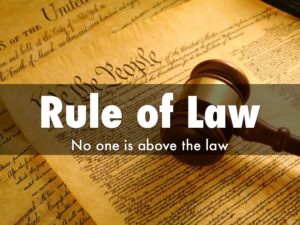 Ransom’s secret weapon has worked! Education and literacy have helped the people understand that through democracy they have the power to defeat Liberty Valance. But Liberty warned them that they might be brave when they were gathered in a large group, but they might have regrets when they were alone. This is pure voter intimidation, very similar to the tactic the Ku Klux Klan used to terrorize Black voters in the South. Let us see whether Vance’s threats were empty or not.
Ransom’s secret weapon has worked! Education and literacy have helped the people understand that through democracy they have the power to defeat Liberty Valance. But Liberty warned them that they might be brave when they were gathered in a large group, but they might have regrets when they were alone. This is pure voter intimidation, very similar to the tactic the Ku Klux Klan used to terrorize Black voters in the South. Let us see whether Vance’s threats were empty or not.
Part 2 – Mr. Peabody, who is completely drunk, has printed “Liberty Valance Defeeted” as the headline for the newspaper. Ooops! He has misspelled it, but everyone will forgive the mistake because the news is so good. Needing more “courage” (alcohol) Peabody goes out into the night. Ford again shows us how segregated the community is with one saloon for Whites and another for Mexicans. But, unlike the “White Only” saloon, the Mexican saloon welcomes non-Mexicans regardless of race and Mr. Peabody is especially welcome because he is a local hero for standing up to Liberty Valance. We are again reminded of Marshall Appleyard’s “mixed” marriage to a Mexican woman through which he is related to the saloon keeper. He cheerfully uses that connection to get credit for Mr. Peabody to buy more whiskey (or perhaps tequila).
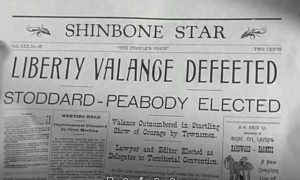 However, nobody will be reading the newly printed edition of The Shinbone Star because when Peabody returns to his office he is confronted by Liberty and his men who not only destroy the newspaper office but also beat Mr. Peabody almost to death. Although Peabody is a half comical character, there is nothing funny about the scene in which Liberty and his men beat him. Comical he may be, but Mr. Peabody is also very brave. Tom had warned him about printing articles that challenged Valance, but Mr. Peabody’s answer was simply that he would “print the truth”.
However, nobody will be reading the newly printed edition of The Shinbone Star because when Peabody returns to his office he is confronted by Liberty and his men who not only destroy the newspaper office but also beat Mr. Peabody almost to death. Although Peabody is a half comical character, there is nothing funny about the scene in which Liberty and his men beat him. Comical he may be, but Mr. Peabody is also very brave. Tom had warned him about printing articles that challenged Valance, but Mr. Peabody’s answer was simply that he would “print the truth”.
All over the world there are men and women just like Mr. Peabody who fight against criminals like Liberty Valance or dictators or terrorists and the only weapon they have is printing or reporting the truth. Being a reporter is one of the most dangerous jobs in the world. Over the past decade (2010-2020), at least 554 reporters and journalists were killed around the world, according to data collected by the Committee to Protect Journalists. Reporters and journalists are also beaten, kidnapped, and imprisoned around the world…but they keep reporting. They keep printing and reporting the truth.
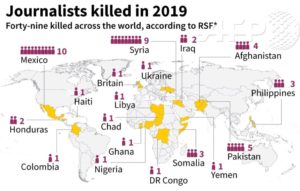 Ransom Stoddard was somewhat reluctant to leave Shinbone, but it seemed he was willing to take Tom’s advice and leave. After all, what good would staying and dying do? But then he sees the badly beaten Mr. Peabody lying in the ruins of his newspaper office. This poor old drunk had the courage to stand up to Liberty Valance and tell the truth. His last words before he falls unconscious are, “I certainly taught Liberty Valance about the freedom of the press!” Beaten almost to death, he is still stubborn and proud…and brave. If Mr. Peabody had the courage to stand up to Liberty Valance then…well, you know what Ransom decides. For Mr. Peabody, telling the truth was worth dying for. Ransom has taught the people that the law is as important as the truth. Now he is willing to die for it.
Ransom Stoddard was somewhat reluctant to leave Shinbone, but it seemed he was willing to take Tom’s advice and leave. After all, what good would staying and dying do? But then he sees the badly beaten Mr. Peabody lying in the ruins of his newspaper office. This poor old drunk had the courage to stand up to Liberty Valance and tell the truth. His last words before he falls unconscious are, “I certainly taught Liberty Valance about the freedom of the press!” Beaten almost to death, he is still stubborn and proud…and brave. If Mr. Peabody had the courage to stand up to Liberty Valance then…well, you know what Ransom decides. For Mr. Peabody, telling the truth was worth dying for. Ransom has taught the people that the law is as important as the truth. Now he is willing to die for it.
Part 3 – The “gunfight” between Ransom and Liberty is the most unequal shooting contest we have seen in any of our films. Poor Bob Canale getting ready to try to draw on Thomas Dunson was certainly overmatched. Torrey drawing on Wilson was definitely over-matched. But at least those two men knew how to use guns. But Ransom, as the Marshall said, “couldn’t shoot the hat off his own head”. He is hopelessly overmatched. But people certainly thought the Ringo Kid was overmatched when he faced all three of the Plummer brothers alone in Stagecoach. In fact, there are some noticeable similarities between the gunfight in Stagecoach and the gunfight in The Man Who Shot Liberty Valance. We might even call them echoes.
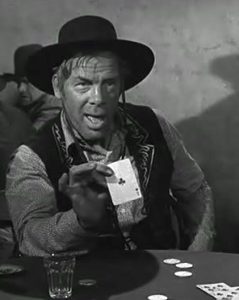 Unusually for Hollywood Westerns, the gunfights in both films take place at night. Real gunfights in the Old West often did take place at night because this tended to be the time when the men were most drunk and most gunfights were cases of drunken men wildly shooting at each other. But Hollywood preferred to stage gunfights in broad daylight. One of the most famous of all Westerns that we have not seen is High Noon (1952), the story of a gunfight that happens at 12:00 noon because that is when the train carrying the main bad guy arrives. But, it would also make sense to have gunfights at this time because at this hour the sun would be at the highest point in the sky. No gunfighter ever wanted the sun to be behind his opponent because the glare might spoil his aim. Similarly, the shadows at nighttime would make it difficult to see an opponent. Liberty tells Ransom “get out of that shadow, dude”.
Unusually for Hollywood Westerns, the gunfights in both films take place at night. Real gunfights in the Old West often did take place at night because this tended to be the time when the men were most drunk and most gunfights were cases of drunken men wildly shooting at each other. But Hollywood preferred to stage gunfights in broad daylight. One of the most famous of all Westerns that we have not seen is High Noon (1952), the story of a gunfight that happens at 12:00 noon because that is when the train carrying the main bad guy arrives. But, it would also make sense to have gunfights at this time because at this hour the sun would be at the highest point in the sky. No gunfighter ever wanted the sun to be behind his opponent because the glare might spoil his aim. Similarly, the shadows at nighttime would make it difficult to see an opponent. Liberty tells Ransom “get out of that shadow, dude”.
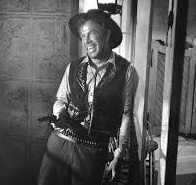 In both films, everyone in the town knows the fight is going to take place and they clear the streets. Both fights are clearly confrontations between good guys and bad guys, between black hats and…well…a white apron, (Ransom is so distracted he has forgotten to take off his apron).
In both films, everyone in the town knows the fight is going to take place and they clear the streets. Both fights are clearly confrontations between good guys and bad guys, between black hats and…well…a white apron, (Ransom is so distracted he has forgotten to take off his apron).
But, perhaps the most significant similarity between the films is the fact that both Luke Plummer and Liberty Valance are playing poker when they hear that their opponent is waiting for them in the street. Both of them “win” the last hand of poker they play with…yikes…aces and eights, the hand Wild Bill Hickok was holding when he was gunned down while playing poker. The events in The Man Who Shot Liberty Valance take place in 1876 as we have said …the same year Hickok was murdered. Ever since Hickok was murdered, aces and eights have been called “the dead man’s hand”, a cursed hand that superstitious gamblers refuse to play lest it bring them bad luck. But, both Luke and Liberty play aces and eights as their last hand before going out to their gunfights (and their deaths).
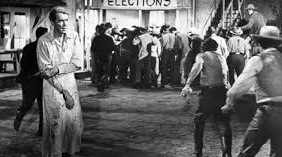 As Liberty plays cards, Marshall Appleyard enters the saloon to beg him not to kill Ransom. But Valance twists the Marshal’s words by saying ‘Oh, so he has a gun in his hand?” and “you heard him call me out”. All of this is the same cunning game that Wilson played with Torrey. A gunfighter could not simply kill a man on the street and walk away, not even in lawless Shinbone. There had to be an excuse. “Western law” (the law of men…but men who valued their honor) did actually have some “do’s and don’ts” that everyone (as a matter of honor) was supposed to obey. You were not supposed to shoot a man in the back. You were also not supposed to shoot an unarmed man. But by the code of honor (and legally speaking), if a man had a gun and was facing you, you were pretty much able to get away with shooting him “in self-defense”; you certainly could do so if the man had drawn his gun and was pointing it at you. In the climactic scene, Ransom faces Liberty with a drawn gun which is all the excuse Liberty needs to kill him. He doesn’t, of course. From what we are able to see, it seems that Ransom, through some amazing stroke of luck, shoots and kills Liberty Valance. He didn’t, of course. We learn the truth at the same time Ransom does.
As Liberty plays cards, Marshall Appleyard enters the saloon to beg him not to kill Ransom. But Valance twists the Marshal’s words by saying ‘Oh, so he has a gun in his hand?” and “you heard him call me out”. All of this is the same cunning game that Wilson played with Torrey. A gunfighter could not simply kill a man on the street and walk away, not even in lawless Shinbone. There had to be an excuse. “Western law” (the law of men…but men who valued their honor) did actually have some “do’s and don’ts” that everyone (as a matter of honor) was supposed to obey. You were not supposed to shoot a man in the back. You were also not supposed to shoot an unarmed man. But by the code of honor (and legally speaking), if a man had a gun and was facing you, you were pretty much able to get away with shooting him “in self-defense”; you certainly could do so if the man had drawn his gun and was pointing it at you. In the climactic scene, Ransom faces Liberty with a drawn gun which is all the excuse Liberty needs to kill him. He doesn’t, of course. From what we are able to see, it seems that Ransom, through some amazing stroke of luck, shoots and kills Liberty Valance. He didn’t, of course. We learn the truth at the same time Ransom does.
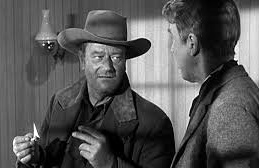 Part Four – Strangely, once Ransom knows that he did not actually kill Liberty Valance, he agrees to allow his career to be built on the false legend that he is “the man who shot Liberty Valance”. Ransom has almost no choice. What else can he do? Tellthe truth? If he does, Tom will be arrested for murder and hanged. He can never tell the story while Tom is alive because Tom saved his life by committing first-degree murder. This is certainly what we call irony.
Part Four – Strangely, once Ransom knows that he did not actually kill Liberty Valance, he agrees to allow his career to be built on the false legend that he is “the man who shot Liberty Valance”. Ransom has almost no choice. What else can he do? Tellthe truth? If he does, Tom will be arrested for murder and hanged. He can never tell the story while Tom is alive because Tom saved his life by committing first-degree murder. This is certainly what we call irony.
But there is more. Ransom knows Tom killed Liberty to save his life but since Ransom was prepared to die fighting Liberty Valance, he wants to know why Tom interfered to save his life. Tom explains very simply, “Hallie wanted you alive”. Tom didn’t kill Liberty for Ransom, he killed him because he was so in love with Hallie that he would do anything for her happiness. He saved Ransom because that was what Hallie wanted him to do.
So, there were actually two men who lost their contests against Ransom Stoddard that night: Liberty Valance and the real man who shot Liberty Valance, Tom Doniphon. Liberty Valance died, but Tom Doniphon might as well have also died. Let’s see why.
Part 5 – Throughout the film, the obvious conflict had been between Ransom and Liberty. Liberty fights with a gun and a whip, and Ransom fought with his books and his courage. But the other conflict was the love triangle between Tom, Hallie, and Ransom. What makes it impossible for Tom to simply call Ransom out is the fact that Ransom was really not trying to steal Hallie. Tom knows this, but he still knows he is losing Hallie to Ransom. Why? Tom is a stronger man than Ransom…with a gun…but Ransom still has his books, the books he uses to teach people, including Hallie, how to read. Ransom also has his stubborn courage. He does not take Tom’s buckboard out of town (which Tom very conveniently arranged for him to take). Ransom stands up to Liberty even though he believes it means death. Of course, Tom had stood up to Liberty, but Tom (and Liberty) knew he could kill Liberty in a gunfight. However, Ransom stood up to Liberty when he believed he could not win in a gunfight. Does that make him a braver man than Tom?
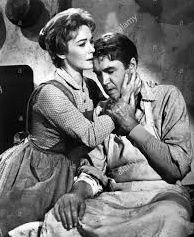 After the gunfight, Hallie is ashamed and admits she wanted Ransom to stay. Part of her wanted him to stay and prove how much he loved her by dying in a fight with Liberty Valance. But, the irony is that while Hallie hoped Ransom would stay because he loved her, that is not the reason why Ransom stayed and fought Liberty. Ransom was not fighting for love (he did not even know that Hallie was in love with him). Ransom stayed and fought because of what Liberty did to his friend Mr. Peabody. If Mr. Peabody could almost die for printing the truth, Ransom felt he could die fighting for what he believed in, the rule of law.
After the gunfight, Hallie is ashamed and admits she wanted Ransom to stay. Part of her wanted him to stay and prove how much he loved her by dying in a fight with Liberty Valance. But, the irony is that while Hallie hoped Ransom would stay because he loved her, that is not the reason why Ransom stayed and fought Liberty. Ransom was not fighting for love (he did not even know that Hallie was in love with him). Ransom stayed and fought because of what Liberty did to his friend Mr. Peabody. If Mr. Peabody could almost die for printing the truth, Ransom felt he could die fighting for what he believed in, the rule of law.
In other words, Ransom was willing to die for what he believed in, but he was not willing to die for love. On the other hand, Tom is willing to kill for love…and he loses everything by doing so.
So, who was the real hero? Was the hero in the film the real man who shot Liberty Valance for love or the man who was willing to die for what he believed in? My answer, of course, is that both men are heroes in their own way. But it is Ransom who wins all the glory and gets the pretty girl. He goes on to be a great man. Tom dies a homeless and lonely drunk.
So this film gives us two kinds of endings. One hero gets the girl and they live happily ever after (like Ringo and Dallas in Stagecoach). The other hero dies a lonely death after sacrificing himself for others (like Shane in Shane).
Part Six – At the end of The Man Who Shot Liberty Valance, the new editor of The Shinbone Star tears up and burns the notes he took while listening to Senator Stoddard tell the true story of who really shot Liberty Valance. He says, “This is the west, Sir. When the legend becomes fact, print the legend”. But that is just the point. Legends are not facts, they are only stories. They are not the truth that Dutton Peabody published no matter what. What is Ford doing in this final scene?
By 1962, John Ford was fed up with “creating legends” and “telling stories” in his films. By the 1960s, John Ford was searching for truth. More than any other director, and perhaps more than any other person, John Ford shaped America’s ideas of the Old West. Like all filmmakers, he had often simply made up stories. He had “printed the legend”. In The Man Who Shot Liberty Valance, the main character is at last attempting to correct the false history of a legendary gunfight in which he was depicted as the hero. The public and mass media created a myth about Ransom Stoddard, which no doubt grew with each telling and retelling. Now that Tom is finally dead, Ransom’s conscience requires him to tell the truth. But it is a truth no one wants to hear.
It is perhaps the greatest irony of John Ford’s life that in his next film, he tries to do exactly the same thing, but again, no one wants to hear the truth.
